
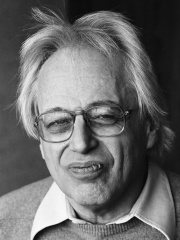
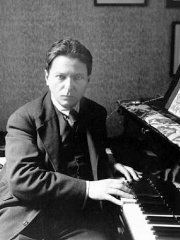
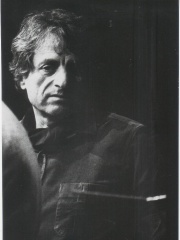

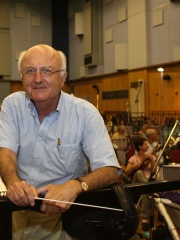


The Most Famous
COMPOSERS from Romania
This page contains a list of the greatest Romanian Composers. The pantheon dataset contains 1,451 Composers, 11 of which were born in Romania. This makes Romania the birth place of the 22nd most number of Composers behind Denmark, and Netherlands.
Top 10
The following people are considered by Pantheon to be the top 10 most legendary Romanian Composers of all time. This list of famous Romanian Composers is sorted by HPI (Historical Popularity Index), a metric that aggregates information on a biography's online popularity. Visit the rankings page to view the entire list of Romanian Composers.

1. Béla Bartók (1881 - 1945)
With an HPI of 80.84, Béla Bartók is the most famous Romanian Composer. His biography has been translated into 84 different languages on wikipedia.
Béla Viktor János Bartók (; Hungarian: [ˈbɒrtoːk ˈbeːlɒ]; 25 March 1881 – 26 September 1945) was a Hungarian composer, pianist and ethnomusicologist. He is considered one of the most important composers of the 20th century; he and Franz Liszt are regarded as Hungary's greatest composers. Among his notable works are the opera Bluebeard's Castle, the ballet The Miraculous Mandarin, Music for Strings, Percussion and Celesta, the Concerto for Orchestra and six string quartets. Through his collection and analytical study of folk music, he was one of the founders of comparative musicology, which later became known as ethnomusicology. Per Anthony Tommasini, Bartók "has empowered generations of subsequent composers to incorporate folk music and classical traditions from whatever culture into their works and was "a formidable modernist who in the face of Schoenberg’s breathtaking formulations showed another way, forging a language that was an amalgam of tonality, unorthodox scales and atonal wanderings."

2. György Ligeti (1923 - 2006)
With an HPI of 74.05, György Ligeti is the 2nd most famous Romanian Composer. His biography has been translated into 51 different languages.
György Sándor Ligeti (; Hungarian: [ˈliɡɛti ˈɟørɟ ˈʃaːndor]; 28 May 1923 – 12 June 2006) was a Romanian-born Hungarian-Austrian composer of contemporary classical music. He has been described as "one of the most important avant-garde composers in the latter half of the twentieth century" and "one of the most innovative and influential among progressive figures of his time". Born in Romania, he lived in the Hungarian People's Republic before emigrating to Austria in 1956. He became an Austrian citizen in 1968. In 1973 he became professor of composition at the Hochschule für Musik und Theater Hamburg, where he worked until retiring in 1989. His students included Hans Abrahamsen, Unsuk Chin and Michael Daugherty. He died in Vienna in 2006. Restricted in his musical style by the authorities of Communist Hungary, only when he reached the West in 1956 could Ligeti fully realise his passion for avant-garde music and develop new compositional techniques. After experimenting with electronic music in Cologne, Germany, his breakthrough came with orchestral works such as Atmosphères, for which he used a technique he later dubbed micropolyphony. After writing his "anti-anti-opera" Le Grand Macabre, Ligeti shifted away from chromaticism and towards polyrhythm for his later works. He is best known by the public through the use of his music in film soundtracks. Although he did not directly compose any film scores, excerpts of pieces composed by him were taken and adapted for film use. The sound design of Stanley Kubrick's films, particularly the music of 2001: A Space Odyssey, drew from Ligeti's work.

3. George Enescu (1881 - 1955)
With an HPI of 71.46, George Enescu is the 3rd most famous Romanian Composer. His biography has been translated into 48 different languages.
George Enescu (Romanian: [ˈdʒe̯ordʒe eˈnesku] ; 19 August [O.S. 7 August] 1881 – 4 May 1955), known in France as Georges Enesco, was a Romanian composer, violinist, pianist, conductor, teacher and statesman. He is regarded as one of the greatest musicians in Romanian history.

4. Iannis Xenakis (1922 - 2001)
With an HPI of 71.29, Iannis Xenakis is the 4th most famous Romanian Composer. His biography has been translated into 46 different languages.
Giannis Klearchou Xenakis (also spelled for professional purposes as Yannis or Iannis Xenakis; Greek: Γιάννης "Ιάννης" Κλέαρχου Ξενάκης, pronounced [ˈʝanis kseˈnacis]; 29 May 1922 – 4 February 2001) was a Romanian-born Greek-French avant-garde composer, music theorist, architect, performance director and engineer. After 1947, he fled Greece, becoming a naturalised citizen of France eighteen years later. Xenakis pioneered the use of mathematical models in music such as applications of set theory, stochastic processes and game theory and was also an important influence on the development of electronic and computer music. He integrated music with architecture, designing music for pre-existing spaces, and designing spaces to be integrated with specific music compositions and performances. Among his most important works are Metastaseis (1953–54) for orchestra, which introduced independent parts for every musician of the orchestra; percussion works such as Psappha (1975) and Pléïades (1979); compositions that introduced spatialization by dispersing musicians among the audience, such as Terretektorh (1966); electronic works created using Xenakis's UPIC system; and the massive multimedia performances Xenakis called polytopes, that were a summa of his interests and skills. Among the numerous theoretical writings he authored, the book Formalized Music: Thought and Mathematics in Composition (French edition 1963, English translation 1971) is regarded as one of his most important publications. As an architect, Xenakis is primarily known for his early work under Le Corbusier: the priory of Sainte-Marie de La Tourette, on which the two collaborated, and the Philips Pavilion at the 1958 Brussels World's Fair (Expo 58), which Xenakis designed by himself.
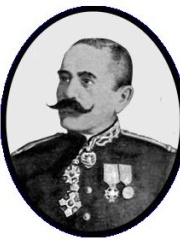
5. Ion Ivanovici (1845 - 1902)
With an HPI of 68.22, Ion Ivanovici is the 5th most famous Romanian Composer. His biography has been translated into 25 different languages.
Ion Ivanovici (Serbian Cyrillic: Јован Ивановић) (alternatively: Jovan Ivanović, Iosif Ivanovici, Josef Ivanovich) (1845 – 28 September [O.S. 16 September] 1902) was a Romanian military band conductor and composer of Banat Serbian origin, best remembered today for his waltz Waves of the Danube.

6. György Kurtág (b. 1926)
With an HPI of 67.77, György Kurtág is the 6th most famous Romanian Composer. His biography has been translated into 29 different languages.
György Kurtág (Hungarian: [ˈɟørɟ ˈkurtaːɡ]; born 19 February 1926) is a Hungarian composer of contemporary classical music and pianist. According to Grove Music Online, with a style that draws on "Bartók, Webern and, to a lesser extent, Stravinsky, his work is characterized by compression in scale and forces, and by a particular immediacy of expression". In 2023 he was described as "one of the last living links to the defining postwar composers of the European avant-garde". He was an academic teacher of piano at the Franz Liszt Academy of Music from 1967, later also of chamber music, and taught until 1993.

7. Vladimir Cosma (b. 1940)
With an HPI of 64.62, Vladimir Cosma is the 7th most famous Romanian Composer. His biography has been translated into 23 different languages.
Vladimir Cosma (born 13 April 1940) is a Romanian composer, conductor and violinist, who has made his career in France and the United States. He was born into a family of musicians. His father, Teodor Cosma, was a pianist and conductor, his mother Carola Pimper a writer-composer, his uncle, Edgar Cosma, composer and conductor, and one of his grandmothers, pianist, a student of Ferruccio Busoni.

8. Péter Eötvös (1944 - 2024)
With an HPI of 63.23, Péter Eötvös is the 8th most famous Romanian Composer. His biography has been translated into 23 different languages.
Péter Eötvös (Hungarian: Eötvös Péter, pronounced [ˈøtvøʃ ˈpeːtɛr]; 2 January 1944 – 24 March 2024) was a Hungarian composer, conductor and academic teacher. After studies of composition in Budapest and Cologne, Eötvös composed film music in Hungary from 1962. He played with the Stockhausen Ensemble between 1968 and 1976. He was a founding member of the Oeldorf Group in 1973, continuing his association until the late 1970s. From 1979 to 1991, he was musical director and conductor of the Ensemble InterContemporain, and from 1985 to 1988 he was principal guest conductor of the BBC Symphony Orchestra, after which he conducted several other orchestras. As a composer, Eötvös was known for the operas Love and Other Demons and Three Sisters, both of which were performed outside Hungary. He was open to influences from different cultures.

9. Bálint Bakfark (1507 - 1576)
With an HPI of 62.26, Bálint Bakfark is the 9th most famous Romanian Composer. His biography has been translated into 22 different languages.
Bálint Bakfark (Hungarian: [ˈbaːlint ˈbɒkfɒrk]; in contemporary sources Valentin Bakfark or (from 1565 onward) Valentin Greff alias Bakfark, his name is variously spelled as Bacfarc, Bakfarc, Bakfarkh, Bakffark, Backuart) (c. 1507 – 15 or 22 August 1576) was a Hungarian composer of Transylvanian Saxon origin, and lutenist of the Renaissance. He was enormously influential as a lutenist in his time, and renowned as a virtuoso on the instrument.
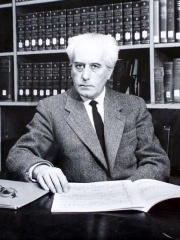
10. Sándor Veress (1907 - 1992)
With an HPI of 58.79, Sándor Veress is the 10th most famous Romanian Composer. His biography has been translated into 16 different languages.
Sándor Veress (Hungarian pronunciation: [ˈʃaːndor ˈvɛrɛʃ], (1907-02-01)1 February 1907 – (1992-03-04)4 March 1992) was a Swiss composer of Hungarian origin. He was born in Kolozsvár/Klausenburg, Transylvania, Kingdom of Hungary, Austro-Hungarian Empire, nowadays called Cluj-Napoca, Romania, and died in Bern. The first half of his life was spent in Hungary; the second, from 1949 until his death, in Switzerland, of which he became a citizen in the last months of his life. Veress studied and later taught at the Franz Liszt Academy in Budapest. Among his teachers were Zoltán Kodály, with whom he studied composition, and Béla Bartók, with whom he studied piano; as an assistant to László Lajtha he did field research on Hungarian, Transylvanian, and Moldavian folk music. Among the composers who studied under him are György Ligeti, György Kurtág, Heinz Holliger, Heinz Marti, Jürg Wyttenbach and Roland Moser. He wrote numerous chamber music pieces and symphonic works. He wrote one opera, Hangjegyek lázadása (1931). Veress was awarded the Kossuth Prize in 1949 in Hungary (though as an émigré he was unable to collect this award) and the Bartók-Pásztory Prize in 1985; in Switzerland he received the Berne canton prize in 1976.
People
Pantheon has 11 people classified as Romanian composers born between 1507 and 1944. Of these 11, 2 (18.18%) of them are still alive today. The most famous living Romanian composers include György Kurtág, and Vladimir Cosma. The most famous deceased Romanian composers include Béla Bartók, György Ligeti, and George Enescu.
Living Romanian Composers
Go to all RankingsDeceased Romanian Composers
Go to all RankingsBéla Bartók
1881 - 1945
HPI: 80.84
György Ligeti
1923 - 2006
HPI: 74.05
George Enescu
1881 - 1955
HPI: 71.46
Iannis Xenakis
1922 - 2001
HPI: 71.29
Ion Ivanovici
1845 - 1902
HPI: 68.22
Péter Eötvös
1944 - 2024
HPI: 63.23
Bálint Bakfark
1507 - 1576
HPI: 62.26
Sándor Veress
1907 - 1992
HPI: 58.79
Sándor Végh
1912 - 1997
HPI: 57.97
Overlapping Lives
Which Composers were alive at the same time? This visualization shows the lifespans of the 7 most globally memorable Composers since 1700.


